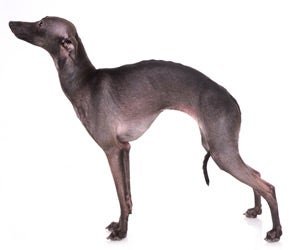Italian Greyhound
-
Overview
Even though they're sleekly built fast runners, don't get these little dogs confused with their larger cousins. The Italian Greyhound is a toy breed. These dogs weigh between 6 and 10 pounds, but they can run up to 25 miles per hour. These little dogs love to snuggle and spend time with their owners. They make excellent companions for owners with plenty of love to give who don't expect their tiny toy dog to join them on jogs or snow-shoeing expeditions, but do expect to spend most of their time in their dog's company.
-
Personality
Italian Greyhounds love to live in the lap of luxury. Their favorite activity is curling up in their owners' lap to snuggle. They are charming, affectionate little dogs who worm their way into the hearts of all they meet with their loving personalities and constant pleas for attention. They can be reserved and timid around strangers, so socialization will help them handle meeting new people without stress. Italian Greyhounds still most enjoy being one-person dogs. They typically don't enjoy sharing the spotlight with children because they believe they are a child, and expect to be treated like one. Italian Greyhounds demand attention from their owners to the extent that they might follow them into the bathroom or attempt to leave the house with them. These tiny greyhounds become extremely devoted to one person, and once they do, they'll stick to them like glue.
They like to play in a fenced-in area. Even though they are curious about everything in their sight, they won't have much desire to lope about extensively, but they should never be let off the leash, because they'll follow anything they perceive as prey. Italian Greyhounds hate the cold and rain to such an extent that some refuse to go outside in harsh weather. They should never be let out in the cold without a protective sweater, or they will start to shiver and become extremely uncomfortable.
-
Coat Care
Italian Greyhounds have short, glossy coats that are so soft that they feel like satin to the touch. This luxurious coat is made for style, not substance. Their light coat causes them to become uncomfortable in the cold. Italian Greyhounds' coats are red, brindle, fawn, black or blue. Some have white markings along their bodies, ears, tails or feet. Italian Greyhounds shed very little, and their hair is so short and fine that it is hardly noticeable.

Brush your Italian Greyhound with a small rubber bristle brush or a small hound glove if their shedding seems to become noticeable.
Italian Greyhounds don't develop a dog odor, so they do not need to be bathed very frequently. They will need to be bathed after rolling around in the mud or romping through something smelly, because their coat does pick up dirt.
Clipping or trimming your dog’s coat is far easier than you would ever imagine. With the right clipper, trimmer and scissors, giving your dog a haircut is easy on your wallet and your schedule.
Dogs with smooth coats generally only require trims and tidying up in areas of excessive hair growth using a trimmer or blunt scissors. It's always wise to take a dog for a short walk or exercise to calm them down before trimming. Remember to brush the coat first to remove any tangles and mats. Don't forget to trim around the paws, pads, tail, chest and sanitary areas, as needed. The coat should lay flat and smooth against the body when finished.
Italian Greyhounds will need to have their nails trimmed at least once a week, because their tiny nails will not be worn down with indoor play.
Not all breeds and coat styles require routine trimming in and around the eyes and ears but all should undergo regular inspection and cleaning around these sensitive areas. Doing so will help prevent the development of infections that could seriously damage these amazing organs.
It is always important to routinely clean your dog's eyes and ears, and examine for potential infections. Some smooth-coated dogs, like Basenjis and Boxers, and dogs with large ears, like Weimaraners and Great Danes, have sensitive ears that should be checked weekly for infection and cleaned with a cotton ball. Gently wipe a cotton ball moistened with mineral oil, olive oil or witch hazel in your dog's ear, being careful to avoid the ear canal. Never use a Q-Tip, which could cause damage to the inner ear if your dog suddenly shakes or jerks his head. Bushy hair growth within the ear can be thinned with tweezers or blunt scissors. Use a small trimmer to trim excess hair around the eyes, ears and face. If you have a small dog, like an Italian Greyhound, take special care to clean around their eyes with a cotton ball or soft cloth and use a small trimmer to trim excess hair around their eyes to make sure they are comfortable. Dogs with facial wrinkles, like French Bulldogs and Boston Terriers, should have their faces wiped down at least weekly to prevent infection.
Italian Greyhounds will need to have their tiny teeth brushed at least twice a week, because their small mouths are prone to dental problems.

 India (English)
India (English)
 Middle East and Africa (English)
Middle East and Africa (English)
 South Africa (English)
South Africa (English)
 Australia (English)
Australia (English)
 Japan (日本語)
Japan (日本語)
 South East Asia (English)
South East Asia (English)
 Singapore (English)
Singapore (English)
 Europe (English)
Europe (English)
 United Kingdom (English)
United Kingdom (English)
 Argentina (Español)
Argentina (Español)
 Brazil (Portuguese)
Brazil (Portuguese)
 Colombia (Español)
Colombia (Español)
 Latin America (Español)
Latin America (Español)
 México (Español)
México (Español)
 Chile (Español)
Chile (Español)
 Peru (Español)
Peru (Español)
 Canada (English)
Canada (English)

